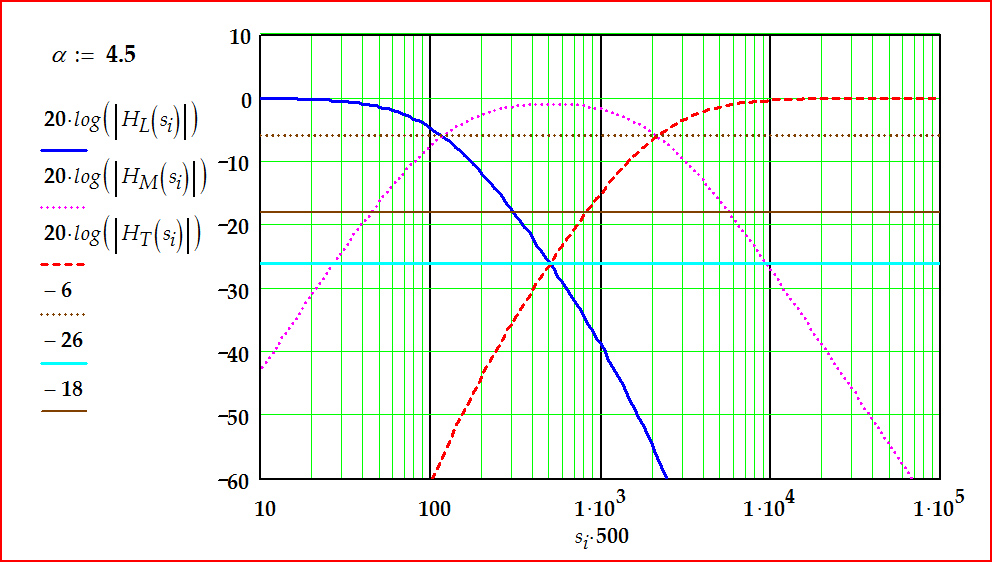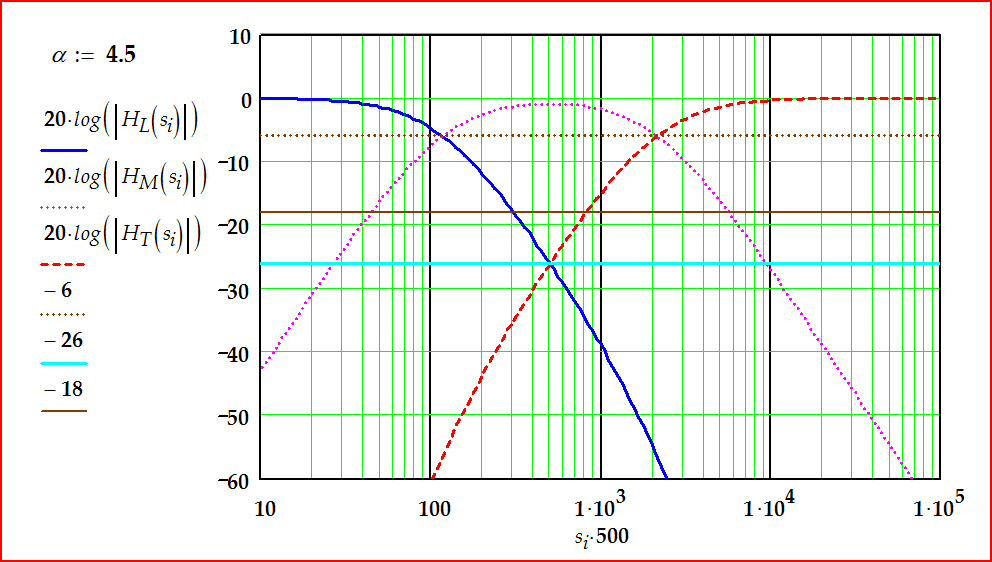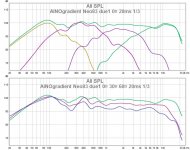Steen Duelund is the father of a modern 3-way elliptic crossover, here is his genuine article http://duelundaudio.com/wp-content/uploads/sites/3621/2013/12/duelund-filter.pdf
from this homepage Articles by Mr. Steen Aa. Duelund – Duelund Coherent Audio
Basically the slopes start gently and get gradually steeper, with good symmetric form which gives phase match. In a three-way the midrange can be a filler with lower spl by itself, helped by woofer and tweeter.

Duelend talks about acoustic response, whic is the point. Many dynamic drivers exhibit a response that is easily made to follow Duelund principle. And it does sound pretty good!
More articles about Duelund style
Duelund and Beyond
Beyond the Duelund 3-way crossover
Crossovers
https://magico.net/technology/crossovers.php
And a minidsp-4-way sort of elliptic by myself (see my footnote for the project)
https://photos.app.goo.gl/hpnhyAsd4aSoNE9C6
from this homepage Articles by Mr. Steen Aa. Duelund – Duelund Coherent Audio
Basically the slopes start gently and get gradually steeper, with good symmetric form which gives phase match. In a three-way the midrange can be a filler with lower spl by itself, helped by woofer and tweeter.

Duelend talks about acoustic response, whic is the point. Many dynamic drivers exhibit a response that is easily made to follow Duelund principle. And it does sound pretty good!
More articles about Duelund style
Duelund and Beyond
Beyond the Duelund 3-way crossover
Crossovers
https://magico.net/technology/crossovers.php
And a minidsp-4-way sort of elliptic by myself (see my footnote for the project)
https://photos.app.goo.gl/hpnhyAsd4aSoNE9C6
Attachments
Last edited:
Steen Duelund is the father of a modern 3-way elliptic crossover, here is his genuine article http://duelundaudio.com/wp-content/uploads/sites/3621/2013/12/duelund-filter.pdf
from this homepage Articles by Mr. Steen Aa. Duelund – Duelund Coherent Audio
Basically the slopes start gently and get gradually steeper, with good symmetric form which gives phase match. In a three-way the midrange can be a filler with lower spl by itself, helped by woofer and tweeter.

Duelend talks about acoustic response, whic is the point. Many dynamic drivers exhibit a response that is easily made to follow Duelund principle. And it does sound pretty good!
More articles about Duelund style
Duelund and Beyond
Beyond the Duelund 3-way crossover
Crossovers
https://magico.net/technology/crossovers.php
And a minidsp-4-way sort of elliptic by myself (see my footnote for the project)
https://photos.app.goo.gl/hpnhyAsd4aSoNE9C6
Juhazi, with all due respect I do not see how in any way, shape, or form the Dueland crossover has anything whatsoever to do with "elliptic" filters or crossovers. Are there any notches present? I have never seen any in a Dueland crossover... in fact there are no mentions of words like notch, elliptic, or Cauer in the pdf you linked to about Dueland's work... so then how can it possibly be "elliptic".
People, please go back and read about WTF an elliptic filter is before you start calling every filter/crossover under the sun "elliptic"!
I was wondering that myself, but it's been a while since I last looked at a Duelund filter so thought my mind could be playing tricks. I've never seen a notched one before, or at least, not one that deliberately uses a notch to increase the initial acoustical roll off.
Below I have written down some additional info on elliptic filters for those who might be interested in learning more or trying them.
First up, what does the response look like? Well, let's look at this cartoon for the basic features of the response:

You see in the figure above the following:
0dB passband reference level
A band of +/-dB of ripple in the passband region. The ripple amplitude can be made to go to zero if so desired.
An "Attenuation" that is the difference between the 0dB passband reference level and the maximum of the returning response between the stopband notches/zeros
Two frequencies are labeled, pb1 and sb1, that highlight the edges of the passband and stopband. In between these is the transition band.
One nice feature about elliptic responses is that all of the parameters mentioned above are to some degree adjustable within a particular order of the filter, or are specified in order to come up with what order filter is necessary to fit the requirements. For example, let's say I want to have ripple=1dB, Attenuation=60dB, sb1/pb1=1.6 times. You will need something like a 5th order filter to meet these requirements. If you instead make the Attenuation=40dB you might be able to use a 4th order filter, or if you instead increase the transition band to sb1/pb1=2.0 you most likely can use a reduced order.
The multiple parameters make the elliptic filter more complicated to design (alot more!) but it's also more flexible in terms of giving you only what you want/need. Unfortunately you need a computer to do the design because the math is very tedious. Luckily there are a few options for this:
Back in 2013 or so I found a DOS program via the web that does all the design of elliptic filters for you given as input sb1/pb1, Attenuation, and ripple. It also can offer optimizations within the order that is then required to meet the specifications, that is to say if a 5th order filter is needed it will also offer you one that provides at least the same amount of Attenuation but either has less ripple or a smaller transition region. This was developed by a scientist in Egypt however I am not sure if it is still available online. Luckily I still have my copy. The output is presented in terms of poles and zeros, etc. but I was able use these to design filters (highpass-notch and lowpass-notch types) that I could then use as the basis for crossovers. Other programs like MATLAB, SCILAB, or commercial filter design software can design an elliptic filter for you. Often you must make some adjustment to this in order to create a useful crossover out of it and it's complement. Reducing the highest Q pole (closest to the transition band edge) helps to achieve a smooth rolloff, mate up with the complementary filter, and will reduce both peak group delay and ringing in the time domain.
Another interesting feature of the elliptic filter response as it related to crossovers is that for modest order the first notch can be made somewhat broad. Recall that the response will fall into the notch before returning up to the level of -Attenuation dB. When working with the driver, the driver response can often begin to itself fall off by the time the elliptical filter response has rebounded out of the first notch. Thus, the combination of filter and driver work well together. Honest there is not really a need (in a loudspeaker) for continued attenuation below -60dB or -70dB since this is below the level at which the driver output needs to be suppressed. Filter types that offer ever-increasing attenuation are at some point not doing anything more for the system - the high amount of attenuation in the stopband is just not necessary.
.
.
.
.
.
Here are some references to read in relation to elliptic filters and crossovers:
1. Iowa Hills page on elliptic filters. This is short, but shows a comparison between a high order Butterworth and moderate order elliptic filter. Also shows time domain response of both (maybe this is the ringing that was mentioned earlier in this thread):
Elliptic Filters
2. Wikipedia page on Elliptic Filters. The sections "Properties" and "Comparison with other linear filters" are of interest mainly:
Elliptic filter - Wikipedia
3. I uploaded a pdf file of lecture notes on elliptic filter. Has a lot of very advanced math but the text and figures are very useful as a reference and info about the elliptical filter response, etc.
4. The DOS program I mentioned was authored by Hercules G. Dimopoulos and is called OPTELLIP. I am attaching a paper by this author that described the math behind the program and the different optimized filter types if offers to the user. The paper is titled "Optimal Use of Some Classical Approximations in Filter Design". Lots of math...
First up, what does the response look like? Well, let's look at this cartoon for the basic features of the response:

You see in the figure above the following:
0dB passband reference level
A band of +/-dB of ripple in the passband region. The ripple amplitude can be made to go to zero if so desired.
An "Attenuation" that is the difference between the 0dB passband reference level and the maximum of the returning response between the stopband notches/zeros
Two frequencies are labeled, pb1 and sb1, that highlight the edges of the passband and stopband. In between these is the transition band.
One nice feature about elliptic responses is that all of the parameters mentioned above are to some degree adjustable within a particular order of the filter, or are specified in order to come up with what order filter is necessary to fit the requirements. For example, let's say I want to have ripple=1dB, Attenuation=60dB, sb1/pb1=1.6 times. You will need something like a 5th order filter to meet these requirements. If you instead make the Attenuation=40dB you might be able to use a 4th order filter, or if you instead increase the transition band to sb1/pb1=2.0 you most likely can use a reduced order.
The multiple parameters make the elliptic filter more complicated to design (alot more!) but it's also more flexible in terms of giving you only what you want/need. Unfortunately you need a computer to do the design because the math is very tedious. Luckily there are a few options for this:
Back in 2013 or so I found a DOS program via the web that does all the design of elliptic filters for you given as input sb1/pb1, Attenuation, and ripple. It also can offer optimizations within the order that is then required to meet the specifications, that is to say if a 5th order filter is needed it will also offer you one that provides at least the same amount of Attenuation but either has less ripple or a smaller transition region. This was developed by a scientist in Egypt however I am not sure if it is still available online. Luckily I still have my copy. The output is presented in terms of poles and zeros, etc. but I was able use these to design filters (highpass-notch and lowpass-notch types) that I could then use as the basis for crossovers. Other programs like MATLAB, SCILAB, or commercial filter design software can design an elliptic filter for you. Often you must make some adjustment to this in order to create a useful crossover out of it and it's complement. Reducing the highest Q pole (closest to the transition band edge) helps to achieve a smooth rolloff, mate up with the complementary filter, and will reduce both peak group delay and ringing in the time domain.
Another interesting feature of the elliptic filter response as it related to crossovers is that for modest order the first notch can be made somewhat broad. Recall that the response will fall into the notch before returning up to the level of -Attenuation dB. When working with the driver, the driver response can often begin to itself fall off by the time the elliptical filter response has rebounded out of the first notch. Thus, the combination of filter and driver work well together. Honest there is not really a need (in a loudspeaker) for continued attenuation below -60dB or -70dB since this is below the level at which the driver output needs to be suppressed. Filter types that offer ever-increasing attenuation are at some point not doing anything more for the system - the high amount of attenuation in the stopband is just not necessary.
.
.
.
.
.
Here are some references to read in relation to elliptic filters and crossovers:
1. Iowa Hills page on elliptic filters. This is short, but shows a comparison between a high order Butterworth and moderate order elliptic filter. Also shows time domain response of both (maybe this is the ringing that was mentioned earlier in this thread):
Elliptic Filters
2. Wikipedia page on Elliptic Filters. The sections "Properties" and "Comparison with other linear filters" are of interest mainly:
Elliptic filter - Wikipedia
3. I uploaded a pdf file of lecture notes on elliptic filter. Has a lot of very advanced math but the text and figures are very useful as a reference and info about the elliptical filter response, etc.
4. The DOS program I mentioned was authored by Hercules G. Dimopoulos and is called OPTELLIP. I am attaching a paper by this author that described the math behind the program and the different optimized filter types if offers to the user. The paper is titled "Optimal Use of Some Classical Approximations in Filter Design". Lots of math...
Attachments
Quite a few years ago Robin Schmidt made a vst plugin called Engineers Filter, very good program for trying out different filter types and slopes. Settings are quick to change and implement.
RS-MET
Thanks you very much, he got a lot more useful tools free to download.
I completely agree! It really is a treasure trove.
Has been one of my go-to pages for a long time, have mentioned it in other threads before, glad you see the value of these wonderful plugins. 🙂
Has been one of my go-to pages for a long time, have mentioned it in other threads before, glad you see the value of these wonderful plugins. 🙂
I downloaded some of the plugins from RS-MET as well as a few of his papers and tutorials. I will have to check them out. So thanks for the link.
Just remember: Elliptic filters have the potential to be absolutely fantastic if they're well implemented, but like any other filter, they are not perfect.
Strenghts/weaknesses and performance/compromise.
Strenghts/weaknesses and performance/compromise.
The Python scipy.signal library has lots of filter design tools (analog and digital) if you're familiar with Python its a great free tool. Basically most of the stuff available in Matlab has free Pythonic versions.
- Status
- Not open for further replies.
- Home
- Loudspeakers
- Multi-Way
- elliptical crossovers
